Hildreth Meière Documentary Series - Watch Trailer
Hildreth Meière Documentary Series - Watch Trailer

Lynn Fausett
(1894-1977)
Credit: L. Tom Perry Special Collections, Harold B. Lee Library, Brigham Young University, Provo, UT
Lynn Fausett, Hildreth Meière’s assistant from 1928-37, was an artist in his own right. While working in Meière’s studio, he served on the Board of Control of the Art Students League in New York from 1927-32, and as the League’s president from 1932-36. Meière herself served on the board of control of the Art Students League, with two terms of vice president in 1927 and 1929. Both had studied at the Art Students League with Kenneth Hays Miller.
As Meière’s assistant Fausett was responsible for enlarging her images, painting models made to various scales, and painting cartoons of her designs in gouache on cartoon paper. According to Lynn Fausett’s brother, Dean, who also assisted Meière starting in 1931,
It was Lynn’s engineering and mathematical ability in interpreting and projecting the small designs up to full scale that made the mural mosaics the success they were. . . .1

Lynn Fausett with his model of the Transfiguration for the half-dome of apse at St. Bartholomew's Church, New York, 1928
During the summer of 1928, Meière visited the Pühl & Wagner factory in Berlin, Germany, to see how the firm’s mosaicists would interpret her painted designs for St. Bartholomew’s Church in the medium of glass mosaic. She was so intrigued by the quality of their work that she stayed on for several days to learn all that she could about the mosaic-making process.2 Meière told August Wagner, the owner, that she would like her assistant Fausett, who was also in Europe, to spend time with the mosaicists as well. Meière described Fausett as “unusually intelligent” and explained, “As he executes most of my large cartoons, it is very essential that he should have this week with you.” As a result of his visit, Fausett concluded that he had been dictating too much to the craftsmen in his preliminary drawings, and from that time on, his final cartoons. . . “allowed for greater freedom of execution by the craftsmen.”3 Meière wrote to Wagner, “Now between us I am sure we will be able to send you some really good cartoons.”4
Fausett painted cartoons for several of Meière’s commissions, including the Nebraska State Capitol in Lincoln, Temple Emanu-El, St. Bartholomew’s Church, the AT&T Long Distance Building, One Wall Street, and Radio City Music Hall in New York. He also painted cartoons for the Baltimore Trust Company Building in Baltimore and Union Station in Kansas City, Missouri.
In describing a visit to Meière’s studio while she and Fausett were working on the medallions for the 50th Street facade of Radio City Music Hall, a reporter wrote:
Over at the easel Mr. Lynn Faucett, Miss Meière’s assistant, was painting in detail in silvery tones the medallions with a figure representing the dance. Even that small section of the design, hardly more than four or five feet square, gave an impressive idea of the brilliantly decorative qualities that will distinguish the work.”5
When the National Council of Women commissioned Meière to paint a mural depicting the Progress of Women for the 1933 Century of Progress International Exposition in Chicago, Fausett painted so much of the full-scale mural that both Meière’s and Fausett’s names appear on the finished work.
The third section of the Progress of Women, where their names appear, is all that remains today of the three-part mural. It is in the collection of the Smith College Museum of Art in Northampton, Massachusetts.

Third section of the Progress of Women, 1833-1933. Smith College Museum of Art, Northampton, Massachusetts. Gift of the National Council of Women to the college
In 1938, Fausett returned to Utah, where he is remembered for work on WPA projects, and murals depicting Mormon pioneers and landscapes of the West. Interestingly, his choice of medium: “a technique employing [gouache] and tempera with oil varnishes rather than oil pigment itself,” refers back to the cartoons he painted in gouache for Meière.6
Interview with Dean Fausett, Salt Lake City, April 21, 1972, by Donald Hague, The Life and Work of Lynn Fausett (master’s thesis, University of Utah, 1975): 35.
For a full description of Meière’s visit to Pühl & Wagner and the mosaic-making process, see Catherine Coleman Brawer and Kathleen Murphy Skolnik, The Art Deco Murals of Hildreth Meière (New York: Andrea Monfried Editions, 2014): 92-98.
Interview with Lynn Fausett, November 4, 1971, in Hague, 36.
Hildreth Meière, letter to August Wagner, September 11, 1928, Pühl & Wagner, Heinersdorff Archive, Berlinische Galerie Museum für Moderne Kunst, Berlin, Germany.
Ethel C. Ince, “Designer of Huge Medallions,” Christian Science Monitor, May 18, 1932.
For further information on Lynn Fausett, see the Lynn Fausett Papers, Harold B. Lee Library, Brigham Young University, Salt Lake City, Utah.